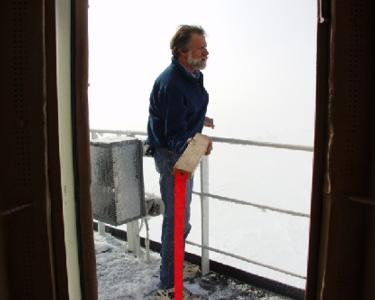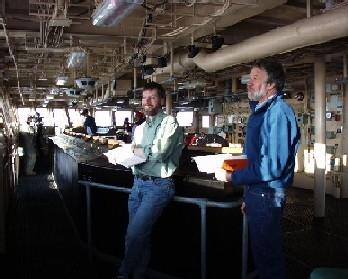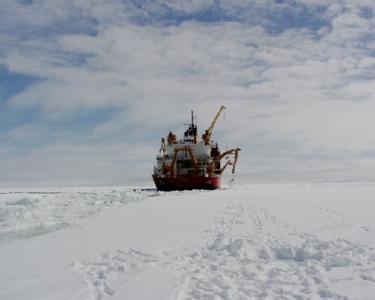11 May, 2000
Level Ice Trials
DRAFT
May 11, 2000
Daily Data (20:30):
Lat. 6802.20622N
Long. 06102.400148W
Heading 324.738
Air Temp. -8.69C 16.36F
True Wind Dir. 320
True Wind Speed 5 knots
USCGC Healy Facts:
Boats-2 LCVPs (Landing Craft Vehicle Personnel), 2 RHIBs (Rigid Hull
Inflatable Boats
Aviation-2 HH-65 helicopters, flight deck, hangar, helo workshop and
storeroom, aviation office
Inuit Language Lesson from Stevie Audlakiak and James Qillaq:
Kalatik (kaw lawk' too): Good to eat
Mamautuk (ma mak' too): Boil (as in boiled meat)
Dear Everyone,
It's a cold and blustery morning with winds around 28 knots creating poor
visibility. Due to the weather, we will not continue our work on the
multi-year ice floe. We will steam southwest instead to search for a first
year floe having level ice around 125 cm thick. A couple of helicopter
reconnaissance flights will be launched to search for an appropriate floe
and, if possible, leads to it. On route, the Healy's engineers will be
testing the Bow Wash System.
What are the Level Ice Trials and why are we testing in level ice? This is
the question I asked Devinder Sodhi, U.S. Army Cold Regions Research and
Engineering Laboratory (CRREL), Hanover, NH. Dr. Sodhi tells me that we are
testing in level ice because it has a fairly constant thickness. If the ice
thickness varies, then the speed of the ship is affected. If the ice
thickness is constant and the speed of the Healy remains stable, then the
capabilities of the ship can be identified in terms of speed at a given
power level for a specified ice thickness.
Level Ice Trials to date have been conducted in ice thicknesses ranging from
60 cm to 170 cm. Tests have occurred in ice 60 cm, 90 cm, 138 cm, and 170
cm thick. It is a question of power versus speed. The tests attempt to
have the Healy maintain a constant power level in a parcticular ice thickness
and then measure the ship's speed.
This is like driving a car and pushing the gas pedal at a constant level for
differing inclines. The results are different speeds for different
inclines. For example, let's suppose that a flat highway and a mountain
road are both straight. Imagine driving on a flat highway or up a steep
mountain road with your foot pushing the gas pedal to the floor. At full
power, will your car move faster on a flat highway or climbing up the steep
mountain road?
Thin ice could be compared to a small incline and thick ice could be
compared to a steep incline. Under full power, the USCGC Healy travels at a
speed of 12 knots in a 66-cm-thick ice sheet and 2.5 knots in an ice sheet
that is 170-cm-thick. Similar to a flat highway, if there is no ice (open
water), the Healy moves at a speed of about 17 knots under full power.
What does "full power" mean? It means that the throttle control is all the
way up to number 10 and all 4 engines are running. It's like flooring the
gas pedal in a car.
So far tests at full power, two thirds, one half, one third, one fourth, and
very low power have been conducted. Because all data is preliminary, it is
unavailable for distribution at this time.
Best regards,
Sandra Kolb

Dr. Devinder Sohdi working in the Healy bridge during the Healy level ice trials. photo by Sandra

Terry Tucker throwing an orange flagged block overboard to mark ship length distances on the floe for the level ice trial. Later, when the ice thickness profiling teams work on the floe, the distances are measured and the blocks are retrieved. photo by Sandra

Robert Wolfe (left) and Terry Tucker (right) in the bridge recording data during the Healy's level ice trials. photo by Sandra

This is an expample of a level ice floe. The USCGC Healy is hove-to for ice thickness profiling. The Healy's track is to the left and our footprints are to the right. photo by Sandra
Contact the TEA in the field at
.
If you cannot connect through your browser, copy the
TEA's e-mail address in the "To:" line of
your favorite e-mail package.
|
